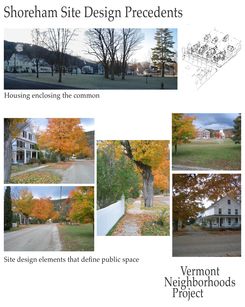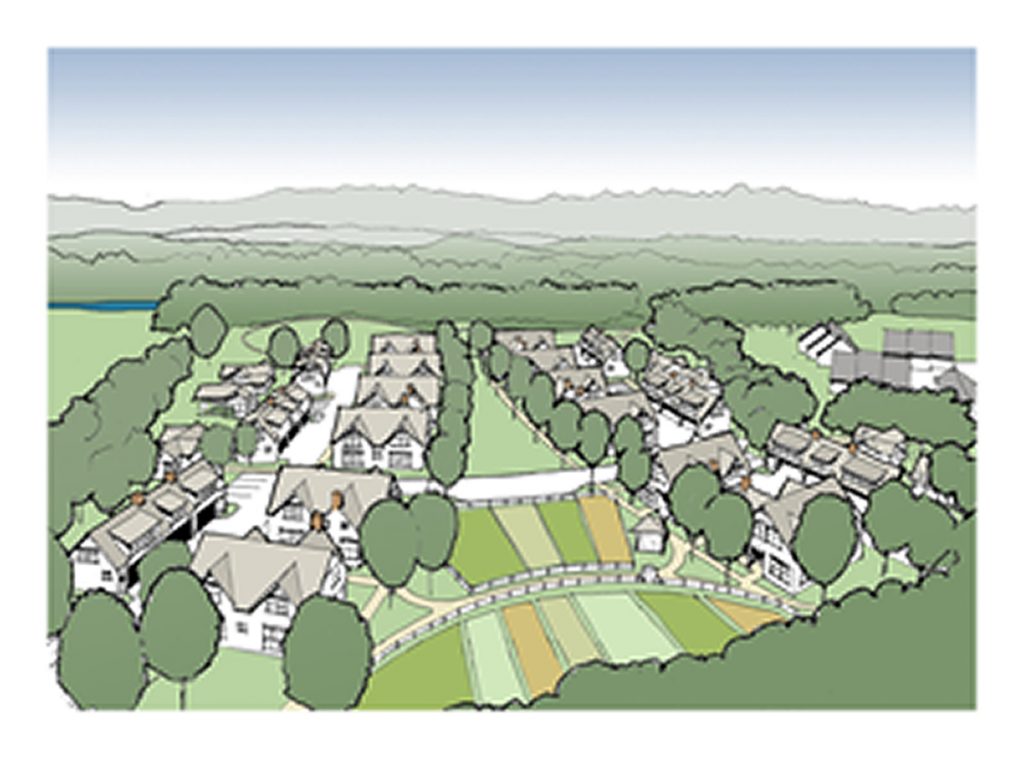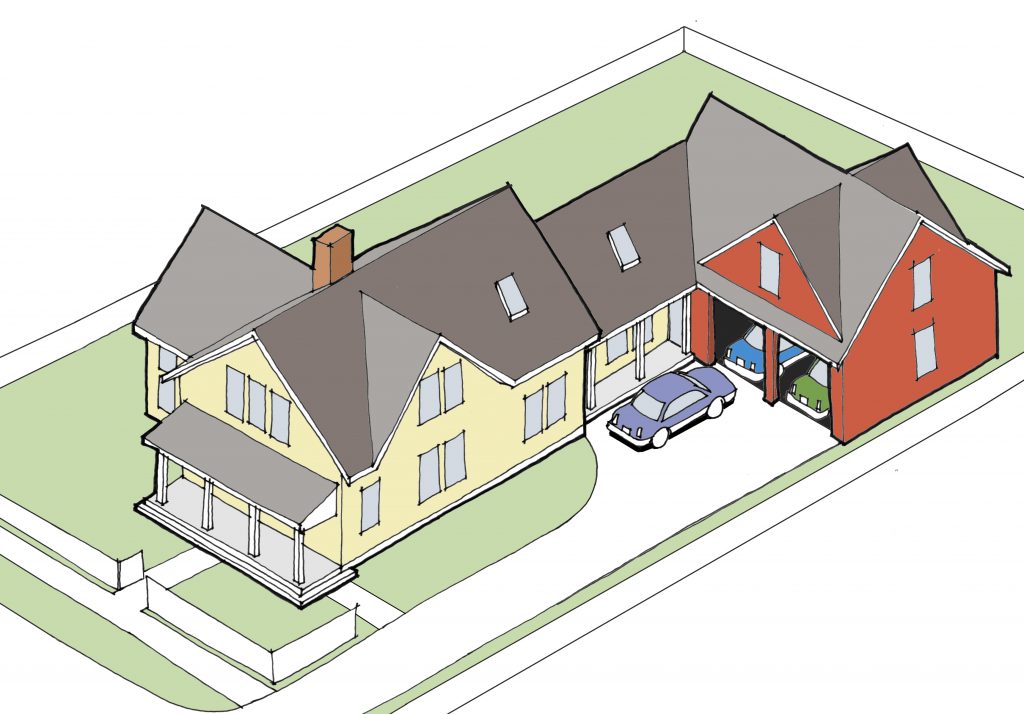Community overview
Addison County is a predominantly agricultural region of Vermont that is experiencing heavy growth pressure from neighboring Chittenden County. Middlebury is the largest community in Addison County, with a sizeable downtown and multiple residential areas. Vergennes is a compact city in the northern part of the county that, like Middlebury, is centered on Otter Creek. Shoreham is a farming village on the gentle ridge that runs through the eastern half of the county, with agricultural operations of many kinds dominating the landscape. All three communities share a desire to locate new residential construction in and around existing built up areas, with the goal of reinforcing their existing community centers while reducing the cost of housing.
Tools you can use
Smart Growth Vermont developed the Vermont Neighborhoods Project as a practical response to the housing-related challenges faced by Vermont communities like Shoreham, Middlebury, and Vergennes. Shoreham expected a 40 percent increase in demand for housing by the year 2025, and its residents wanted to ensure that new growth was consistent with the character of their rural town and its compact village center. Middlebury and Vergennes were facing a similar rate of growth and wanted to protect and reinforce the compact character of their traditional neighborhoods. Smart Growth Vermont proposed the Vermont Neighborhoods Project as a series of design charrettes that brought together a wide range of stakeholders in each community, with the goal of creating a site-specific concept plan for a new neighborhood in each community that met housing demand while preserving community character.
Once a site was selected in each community, the first step was to identify the key stakeholders whose participation was crucial to the success of each project. This group included select board members, neighbors, developers, and other influential and active community members. The project team then drew initial site plans and drafted basic guidelines for the process. In Shoreham, for example, these guidelines included honoring “the historic setting of the village green with appropriate site design and landscaping,” as well as considering the implications of both existing and proposed new zoning.
The next step was to organize the first charrette in each community, with the goal of soliciting ideas and identifying important issues. Smart Growth Vermont began the charrettes with an overview of the goals and process of the Vermont Neighborhoods Project, an orientation to basic Smart Growth principles, a presentation on Smart Growth in New England, an examination of the opportunities and constraints at each site, and a summary of housing market conditions.
After this opening presentation, participants split up into small groups for the design sessions at the heart of the charrette process. Each group reviewed the basic guidelines for its community, identified potential problems with draft plans for the site, and developed alternatives to deal with these issues. The groups reconvened to report on the high points of their discussions. The design teams then used these discussions to draw up a more detailed set of site plans for each community.
The team then led a second set of charrettes to review and evaluate the various design alternatives that came out of the first charrette. These charrettes began with an introduction of important stakeholders as well as a review of the Vermont Neighborhoods Project and of high points from the previous charrette. The team presented the various alternatives, and the participants once again broke out into groups to discuss them. After this discussion, the groups shared their ideas and concerns with each other and with the organizers. Finally, the designers used this information to revise and finalize the site plans.
The end result of the Vermont Neighborhoods Project was a collection of tangible and intangible products for each town that participated, including an in-depth report that identified what the town valued and wanted to preserve (including historical and natural features and traditional patterns of development), as well as what community members felt was lacking in their town. The report also included one or several detailed alternatives for each site, which incorporated the stated values and needs of the community into the final product. Beyond the report itself, the process generated broad community support by ensuring that the ideas for the projects had come from community members themselves.
Of the three communities, the town of Shoreham has moved farthest towards implementation of the design charrette principles and concepts. In 2008 and 2009, Jeremiah Parker Restoration, a small construction company based in Shoreham, worked with the town and with the Addison County Community Trust to create new affordable housing in the new Green Woods Village development, immediately adjacent to Shoreham Village. The development includes new energy efficient homes as well as two homes that were created through the rehabilitation of a historic local farmhouse that was moved to the site. Shoreham is also considering revisions to its zoning bylaw that will promote compact new development in the village.

Design elements for the Shoreham project, based on existing homes in the community 
Conceptual design developed for the Middlebury site 
A house design created for the project
Tip: Partners are key!
Bringing in a wide range of partners was a key element in the success of this project. While Smart Growth Vermont (known at the time as the Vermont Forum on Sprawl) coordinated the project, Housing Vermont, the Hartland Group, the National Bank of Middlebury, the Vermont Association of Realtors, TruexCullins & Partners Architects, Nancy Nye Consulting, and the Vermont Housing Finance Agency all served as members of the project steering committee. In addition, ORW Landscape Architects & Planners was contracted as the designer for the charrettes. Working together, these partners met the goal of the project: to encourage neighborhood development that fosters vibrant communities, helps alleviate Vermont’s housing shortage, and protects the environment.
Lessons Learned
- Identify and meet with key stakeholders up front. When vocal community members are given the opportunity to express themselves ahead of time, they are more likely to give others a chance to speak during the actual charrettes, allowing for a smoother and more effective process.
- Work with builders throughout. Taking community ideas to experienced developers and builders between charrettes helps keep designs realistic and feasible.
- An absolute minimum of two charrettes is required. The first makes your intent as the organizer clear to the community in order to deal with any potential conceptual objections to the process. The second allows the community to explore a range of options for how the project might proceed. Third and subsequent meetings should be added if the second meeting does not result in a workable final product.
- Incorporate design expertise. A good design professional who can distill the community’s input into compelling visuals is crucial.
- Guide as well as follow. Place the ideas and perspectives of participants front and center, but do not hesitate to offer guidance within the context of overall community preferences.
Related Issues
Related Tools




